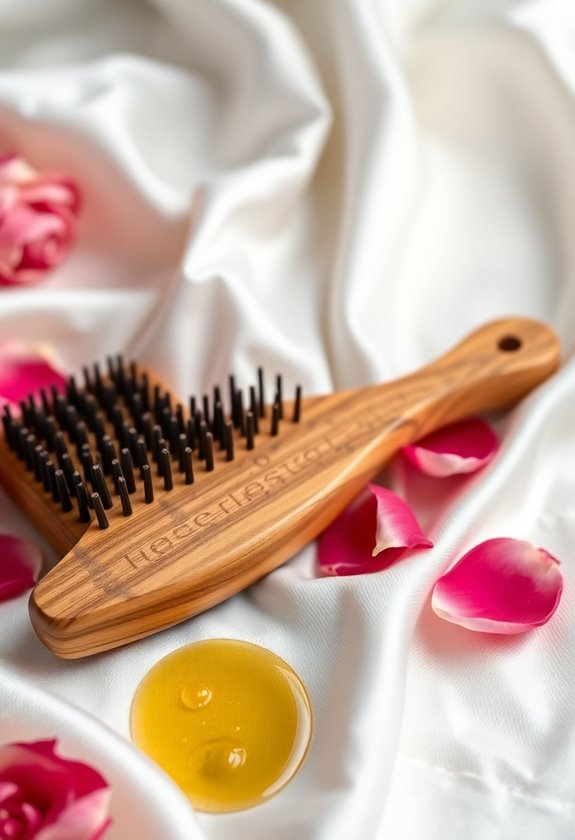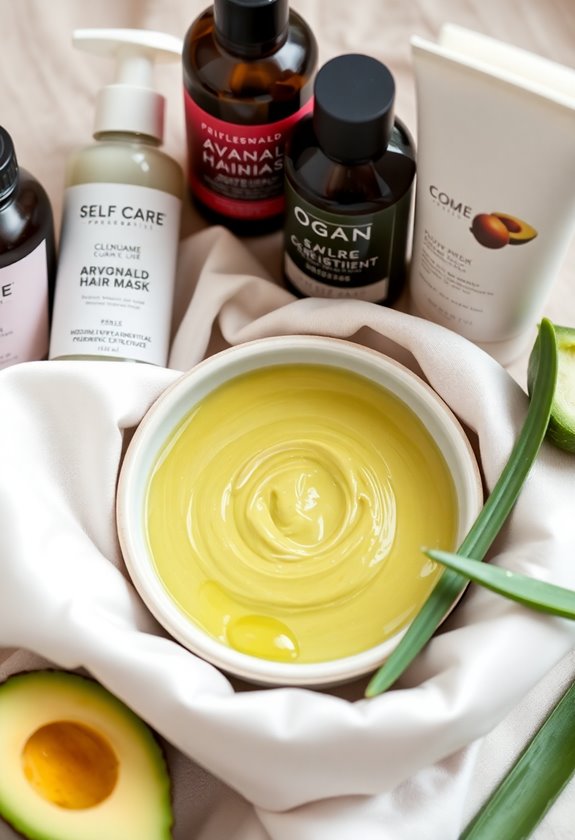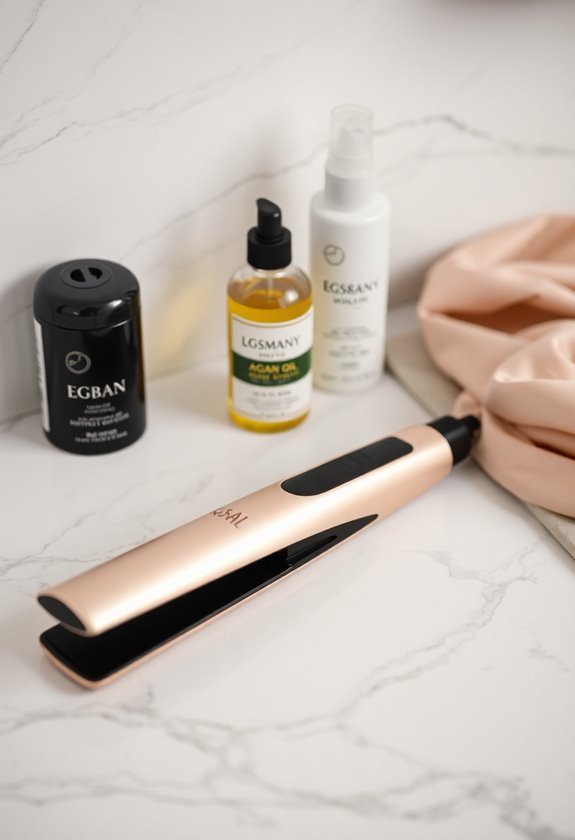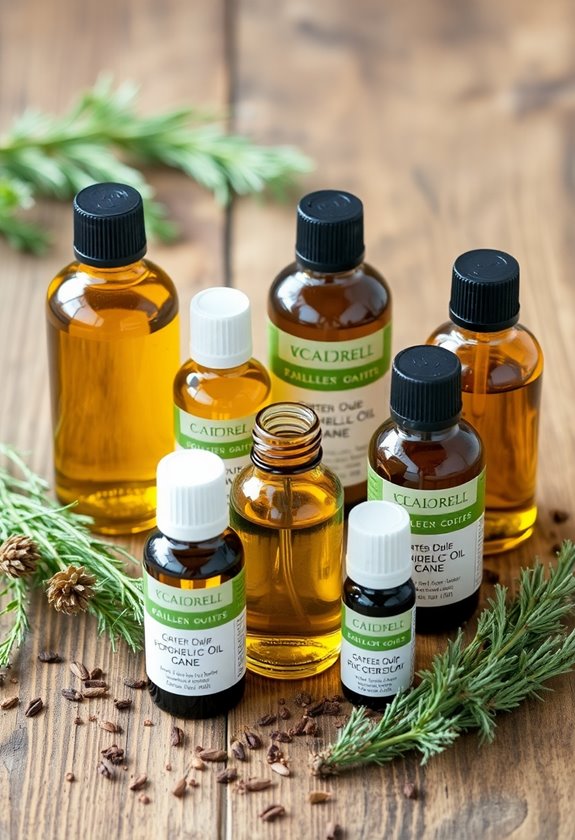Start your morning hair care routine by gently detangling from bottom to top with a wide-toothed comb, using detangling spray for stubborn knots. Next, apply leave-in conditioner and heat protectant to damp hair, focusing on mid-lengths to ends. Follow with your deep conditioning treatment if it's a treatment day, letting it sit for 15-30 minutes. Then, dry your hair using a microfiber towel to reduce frizz, patting gently in sections. Finally, style with heat tools between 300-450°F, depending on your hair type, keeping the tool moving to prevent damage. These foundational steps set the stage for understanding advanced hair care techniques.
Highlights
- Start with gentle detangling using a wide-toothed comb, working from bottom to top to minimize breakage and damage.
- Pat hair dry with a microfiber towel instead of rubbing to reduce frizz and prevent tangles.
- Apply leave-in conditioner to damp hair, focusing on mid-lengths and ends for protection and moisture.
- Use heat protectant spray before blow-drying or styling, keeping tools at appropriate temperature for your hair type.
- Finish with anti-frizz serum or smoothing cream to seal the hair cuticle and maintain style throughout the day.
Gentle Detangling

Starting from the bottom and working your way up, detangle your hair carefully with a wide-toothed comb or detangling brush. Hold each section firmly near the roots to prevent pulling and tugging that can damage your strands or cause breakage.
- If you're dealing with stubborn knots, use a detangling spray to make the process easier and reduce friction.
- Don't rush through this step – take your time to avoid causing unnecessary stress to your hair shaft.
- For curly or textured hair, section your hair into manageable parts using hair clips before you begin detangling.
When you encounter resistance, stop and gently work through the tangle using your fingers first, then follow with your detangling tool, which will help preserve your hair's natural texture while preventing unnecessary damage.
Protective Product Application

Your hair needs protection before styling to prevent damage from heat, environmental factors, and daily wear. Start by applying a leave-in conditioner to damp hair, focusing on the mid-lengths to ends where your strands are most vulnerable to breakage.
- Apply a heat protectant if you'll be using hot tools, making sure to distribute it evenly through your hair with a wide-toothed comb.
- Layer on an anti-frizz serum or smoothing cream to seal the hair cuticle and provide additional protection against humidity.
- If you've got fine hair, use lightweight products and focus application on the ends to avoid weighing down your roots.
- For thick or coarse hair, you'll want to use richer protective products that can deeply penetrate the strands while providing lasting moisture.
Similar to how facial moisturizers help keep skin radiant, protective hair products maintain your hair's natural shine and health throughout the day.
Deep Conditioning Treatment

Along with daily care, deep conditioning treatments play an essential role in maintaining healthy, moisturized hair. You'll want to apply this intensive treatment once or twice a week, focusing on distributing the product evenly from roots to ends. When you're selecting a deep conditioner, look for ingredients like keratin, argan oil, or shea butter that can penetrate deeply into your hair shaft. Premium hair products offer specially formulated deep conditioners designed for different hair textures and concerns.
- Apply the treatment to damp, freshly shampooed hair
- Section your hair into manageable parts for thorough coverage
- Leave the product on for 15-30 minutes under a shower cap
- Rinse thoroughly with cool water to seal the cuticles
For best results, you'll notice the most significant improvement when you're consistent with your deep conditioning schedule and choose products that match your specific hair type.
Proper Hair Drying Techniques

The way you dry your hair can greatly impact its health and appearance. To minimize damage and maintain healthy locks, you'll want to follow these essential techniques:
- Gently squeeze out excess water with a microfiber towel instead of rubbing vigorously with a regular towel, which can cause frizz and breakage.
- Start by patting your hair from roots to ends, working in sections to remove moisture without creating tangles or friction.
- If you're using a blow dryer, don't forget to apply a heat protectant first, and keep the dryer about six inches away from your hair while moving it continuously.
- For the healthiest results, let your hair air-dry until it's 80% dry before using any heat styling tools, and always use the cool shot button to seal your hair cuticles.
Strategic Heat Styling

Smart heat styling involves three key principles that protect your hair while achieving your desired look. You'll need to prep your strands with heat protectant, maintain proper temperature settings for your hair type, and use the right techniques for your styling tools.
- Always apply a heat protectant spray or serum to damp hair, ensuring complete coverage from roots to ends
- Set your styling tools between 300-400°F for fine hair, and up to 450°F for thick or coarse hair
- Keep heat tools moving continuously to prevent concentrated heat damage in one spot
- Create sections no wider than your styling tool's barrel or plate width for even heat distribution
When you're heat styling, watch for steam and listen for sizzling sounds, which indicate your hair's too wet or the temperature's too high for safe styling.
Frequently Asked Questions
How Often Should I Trim My Hair to Maintain a Healthy Morning Routine?
Like a well-tended garden, your hair needs regular trimming to stay healthy and vibrant. You'll want to schedule haircuts every 8-12 weeks to prevent split ends and maintain your style. If you're growing your hair out, you can stretch this to 12-14 weeks, but don't skip trims entirely. Fine or chemically treated hair needs more frequent cuts, while coarse or natural hair can often go longer between trims.
Can I Use Dry Shampoo as Part of My Morning Hair Care Routine?
You can definitely use dry shampoo as part of your morning routine when you don't have time for a full wash. Apply it to your roots before bed or in the morning, letting it sit for 2-3 minutes to absorb excess oil. For best results, you'll want to use it no more than 2-3 times between regular washes, as overuse can lead to product buildup and scalp issues.
Should I Brush My Hair When It's Still Wet in the Morning?
You shouldn't brush your hair when it's wet because your strands are most vulnerable to breakage and damage in this state. Instead, use a wide-toothed comb to gently detangle your hair from the bottom up, working in small sections. If you must style wet hair, consider using a detangling spray and a specialized wet brush that's designed with flexible bristles to minimize stress on your delicate strands.
What's the Best Time to Wash Hair – Morning or Night?
Both morning and evening hair washing have their benefits, but nighttime washing is often the better choice. When you wash at night, your hair has time to air-dry naturally, which reduces heat damage and breakage from styling tools. Morning washing can leave you rushing to dry your hair before work, while evening washing lets you wake up with manageable hair that only needs minimal styling.
Does Sleeping With a Silk Pillowcase Really Make a Difference for Morning Hair?
Your ordinary cotton pillowcase might be secretly sabotaging your hair while you sleep! A silk pillowcase can make a noticeable difference by reducing friction, which helps prevent tangles, frizz, and breakage during your nightly tossing and turning. You'll likely wake up with smoother, more manageable hair because silk's smooth surface doesn't absorb your hair's natural oils like cotton does, and it helps maintain your hair's moisture balance throughout the night.




